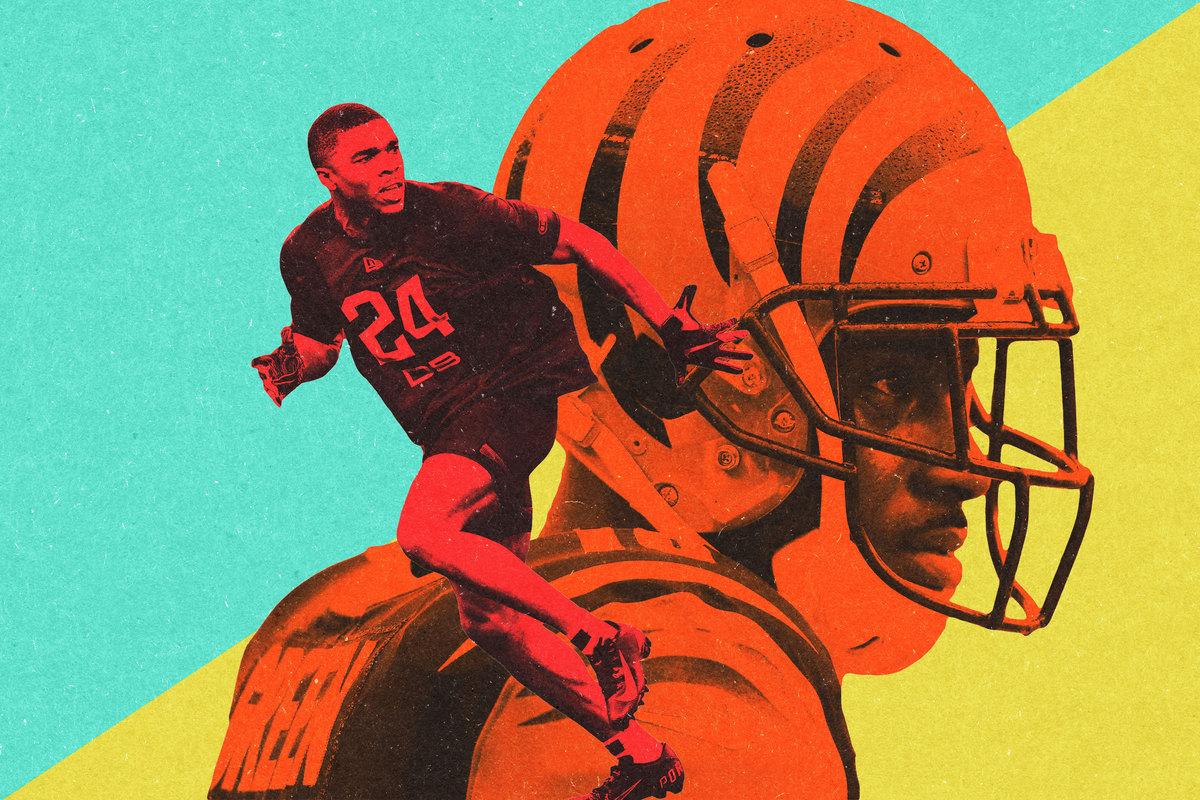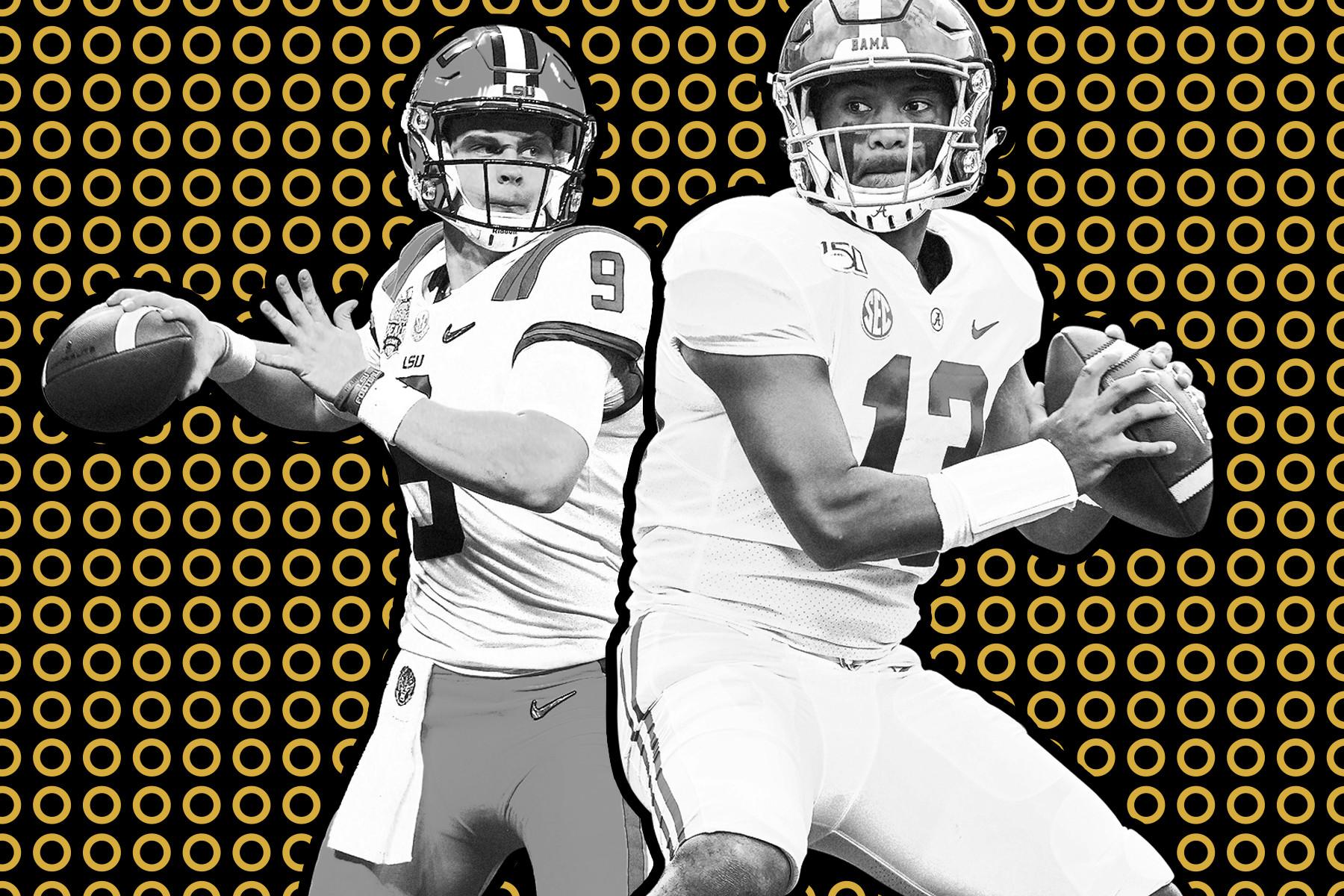
1. The draft’s top defensive backs took care of business Sunday. Heading into the combine, Ohio State’s Jeff Okudah and Florida’s CJ Henderson were considered the consensus top two cornerbacks in this year’s class. That shouldn’t change after both had strong showings in Indianapolis. Okudah took a nasty fall during on-field drills, but that didn’t stop him from coming back and posting a 41-inch vertical leap later in the day. The 205-pounder also ripped off a 4.48-second 40-yard dash. Joe Burrow, Tua Tagovailoa, and Chase Young are likely to be the first three players off the board in late April, but Okudah isn’t far behind. While there’s no such thing as a perfect prospect, Okudah is pretty close. A team like the Giants will be very happy if Burrow and Tagovailoa go 1-2 and Okudah falls into their lap.
Several less-heralded prospects also helped their cause. Southern Illinois’s Jeremy Chinn ran a 4.45-second 40, posted an 11-foot, 6-inch broad jump, and hit 41 inches in the vertical—all at 221 pounds. Chinn was pegged as a late-round flier going into the weekend, but you can bet some team is going to take an early chance on him with those types of testing numbers. Kyle Dugger out of Division II Lenoir-Rhyne also had a day to remember. The 217-pound Dugger ran a 4.49-second 40 and posted a 42-inch vertical. That’s like having Vince Carter at safety. It’s not easy to become a high-level prospect from a Division II school, but Dugger has done exactly that.
2. The 2020 draft appears to feature the deepest class in a long time. It feels like we say this about a draft every few years, but it’s hard to argue with the assessment this time around. More than 20 defensive backs ran sub-4.5 40s. A loaded receiver class performed even better than expected in terms of measurables and on-field workouts, with Alabama’s Jerry Jeudy and Henry Ruggs III stealing the show. Do-it-all Clemson defender Isaiah Simmons ran a ridiculous 4.39 40 at 238 (!) pounds. And Louisville tackle Mekhi Becton clocked a 5.1 40 at 364 pounds earlier in the weekend—the fastest time for a player weighing more than 350 pounds since 2003.
Becton expected to put up more than the 23 reps he managed on the bench press, but a source told me he was forced to complete the drill without warming up after a couple of other players declined to participate. Forcing these prospects to do a vertical jump at 10 p.m. after being poked and prodded all day seems ridiculous, but the combine’s recent scheduling change didn’t appear to have a negative effect on the actual numbers. This is a loaded, athletic class that should produce some real steals in the middle rounds.
3. The Bengals reportedly plan to use the franchise tag on A.J. Green. ESPN’s Dan Graziano and Jeremy Fowler reported that Cincinnati will tag the 31-year-old receiver, who is coming off the final season of a four-year, $60 million contract. The Bengals seem determined to hold on to the veteran who missed the entire 2019 campaign with a foot injury suffered early in training camp, and it’s a curious plan for a rebuilding team. Green likely would’ve fetched a high pick on the trade market midway through last season, and burning more than $18 million to tag him in 2020 doesn’t make a lot of sense for a franchise that’s still a long way from contention. There’s an argument that retaining Green could aid the development of presumptive no. 1 pick Burrow, but giving a 30-something receiver market-setting money only to watch him leave the following year probably isn’t the most prudent financial move.
It’s possible that the Bengals are tagging Green now so they can trade him later this spring, similar to what happened with Jadeveon Clowney, Frank Clark, and Dee Ford in 2019. That kind of bold move would feel out of character for a typically cautious organization like Cincinnati, though.
4. Rumors about the Bears’ quarterback plans are starting to heat up. The Athletic’s Paul Dehner Jr. reported last week that Chicago has “been in touch” with Cincinnati about trading for Andy Dalton, and ESPN’s Fowler reported that there’s a “strong sense” the Bears are looking to add a veteran quarterback to push Mitchell Trubisky this season. Both general manager Ryan Pace and head coach Matt Nagy have publicly stated that Trubisky will be Chicago’s starting quarterback to open the 2020 season, but the direction the Bears go in the coming months will send a significant message about how attached they are to that plan.
Money talks in the NFL. If Chicago adds a cheap veteran option like Marcus Mariota or Case Keenum in free agency, it will signal that Pace wants to do everything in his power to tip the scales in Trubisky’s favor while adding some element of competition to appease a restless fan base. Trading for Dalton would be different. In that case, Chicago would likely try to convince Cincinnati to pay some of Dalton’s $17.7 million cap hit next season in the same way that Tennessee did with Ryan Tannehill. Even if that happened, though, Dalton’s track record and the Bears’ willingness to give up draft capital would suggest that Chicago is serious about pushing Trubisky this season. If the Bears don’t pick up Trubisky’s fifth-year option this spring and add a QB like Dalton on a one-year deal, that would provide a roadmap for the franchise to pursue its QB of the future in 2021 when it has the draft resources to make an aggressive move.
Chicago doesn’t have the money or picks to make a splashy acquisition this offseason. Still, Pace needs to do something to maximize the considerable defensive talent that’s on the Bears roster.
5. Position fit will be a popular topic of conversation in March. People in Indy were split on where Clemson’s Simmons will play in the NFL. He’s absolutely big enough at 238 pounds to be a linebacker, but some sources I talked to believe that he can maximize his impact as a safety who fills a variety of roles. Think Derwin James during his rookie year. Expect to hear plenty of chatter about Simmons’s future leading up to the first round; smart teams could use him as safety in some game plans and the end man on the line of scrimmage in others.
Chase Claypool is another fascinating case. The Notre Dame product is 238 pounds, and some expected him to shift to tight end in the NFL. After running a 4.42-second 40, though—seriously, was there something in the water this year?—teams will likely be more open to deploying him as a receiver at the pro level. Only one other receiver since 2003 has been at least 6-foot-4, weighed at least 235 pounds, and clocked a sub-4.45 40 at the combine: Calvin Johnson.
